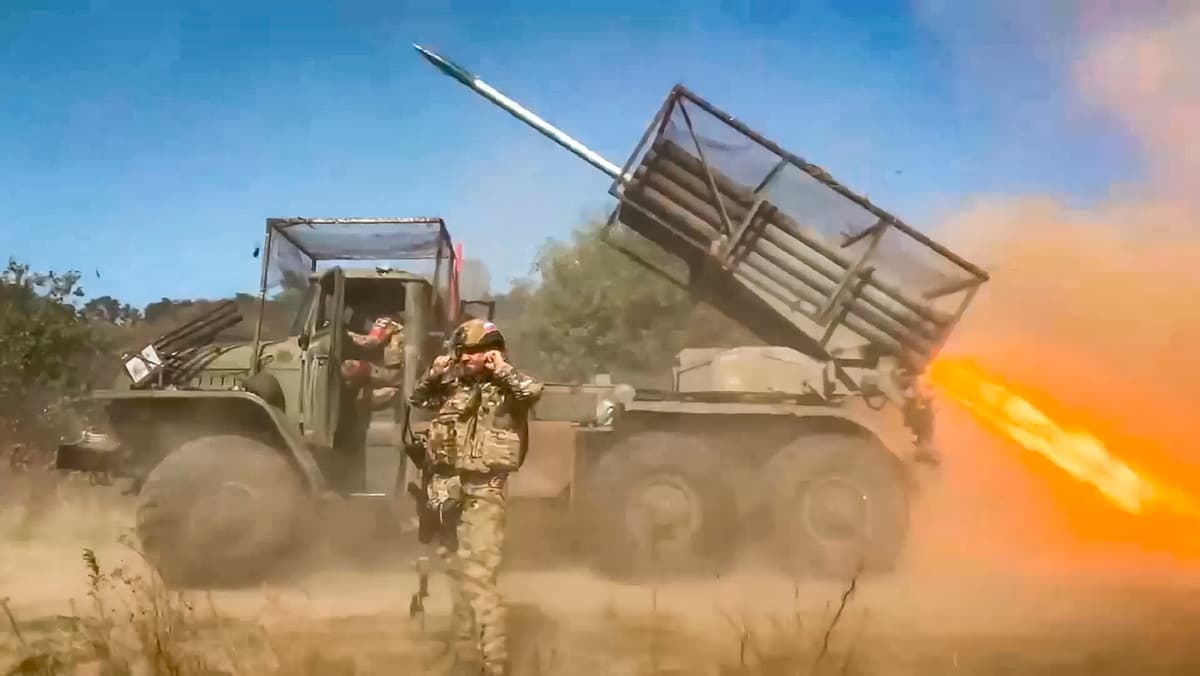Ukraine, Without Waiting for Washington’s Permission To Use Long-Range Missiles, Blows Up Ammo Dumps Deep Inside Russia
While Moscow and Washington cross policy swords over missile use, Ukrainian drones are accomplishing much of what the Western cruise missiles could do.

President Zelensky returned home empty handed from Washington last weekend. President Biden refused to authorize use of American, British, and French “long range” missiles on military targets as deep as 190 miles inside Russia.
Meanwhile, shortly after the president’s train rolled into Kyiv, a wave of 75 Ukrainian-made drones took off from Eastern Ukraine and headed for an ammunition depot 300 miles inside Russia. It was the fifth ammo dump in 10 days targeted by Ukraine — each one 200 miles or more inside Russia. While Moscow and Washington cross policy swords over missile use, Ukrainian drones are accomplishing much of what the Western cruise missiles could do.
After the smoke cleared from the latest attack, on Kotluban, 300 miles east of Ukraine, satellite photos disclosed it was the only failed mission of the five. The drones, or their debris, set off large grass fires in the drought-stricken area. The adjacent depot escaped unscathed.
American missiles would be more accurate. Yet Ukraine’s kamikaze drones are taking a big toll, destroying some of the biggest ammunition caches in European Russia, reports the Washington-based Institute for the Study of War. With American missiles off the table, Russia’s army has been careless, stacking its ammunition out in the open.
“Western restrictions prohibiting Ukraine from firing Western-provided weapons into Russia have granted the Russian command flexibility to not properly protect its rear areas,” the nonprofit research group wrote last week. “This flexibility has granted Russia the ability to optimize large rear staging facilities to marshal massed materiel to Ukraine at scale.”
“Paratrooper’s Diary,” a Russian military blogger, complained last week that the Defense ministry does not segregate ammunition stocks into small units, often does not store them underground, and that warehouses and berms are clearly visible from satellites. Most of the six major ammunition depots in European Russia date from the Cold War, when they were constructed to support the Warsaw Pact.
Ukrainian intelligence officials say drone attacks are timed to coincide with open-air unloading of munitions trains from central Russia, Iran, and North Korea. The impact is real.
“These were depots of Russian tactical missiles and guided aerial bombs — all the things that Russia uses to terrorize our cities, our positions,” Mr. Zelensky told the nation after the largest blast, at Toropets, Russia, about 300 miles north of Ukraine.
The Toropets blast was detected by earthquake monitors in Estonia. Estonia’s Defence Forces Intelligence head, Colonel Ants Kiviselg, estimated the explosions destroyed 30,000 tons of explosives, the equivalent of two months to three months worth of shells used by Russia’s military. He told Estonia’s ERR news site: “Russia has suffered ammunition losses as a result of this attack, and we will see the impact of these losses on the front in the coming weeks.”
The Toropets explosion blew a nearly 100-yard wide crater in the earth, rattling windows at Moscow, 250 miles to the east. Four days later, the Toropets depot was still burning when NASA satellites detected a second set of fires 10 miles to the south. Ukrainian drones had bombed a second ammo dump.
American Army tactical cruise missiles sent to Ukraine have a maximum range of 190 miles. Believing Ukraine would win permission to use them against Russian targets, Moscow moved its bomber jets out of this range and clustered the Black Sea Fleet on the eastern shore, surrounded with anti-aircraft defenses. However, ammunition dumps are cumbersome to move.
“Ukrainian attacks are now visibly expanding in scale as more drones are produced, and are also routinely reaching targets deep inside Russia over one thousand kilometers beyond the Ukrainian border,” Georgian political analyst Giorgi Revishvili writes in an Atlantic Council essay titled: “Ukraine’s expanding drone fleet is flying straight through Putin’s red lines.”
Ukrainians have learned not to advertise their war plans. Some analysts suspect that Kyiv is quietly shifting from slow, propeller driven drones to its new Palianytsia cruise missiles. Unveiled in August, this Ukrainian-made “drone missile” can carry a warhead of several hundred pounds up to 400 miles.
“Russians on the ground in Toropets reported hearing jet engines overhead before the local munitions stockpile exploded,” Forbes military and aerospace writer David Axe writes of the third ammo dump attack. “It’s increasingly evident, though not yet confirmed, that the Ukrainians are using their latest explosive unmanned aerial vehicle — the jet-propelled Palianytsia ‘missile drone’ for these devastating raids.”
Yesterday, Mr. Zelensky announced that Ukraine’s first domestically-produced ballistic missile successfully passed flight tests. During the Soviet era, engineers in Ukraine designed and built the intercontinental ballistic missiles that threatened America.
Today, Ukrainian rocketry expertise again draws international attention. A retired Australian major general, Mick Ryan, wrote last week: “Ukraine’s development of its continuously evolving strategic strike complex has been a very impressive achievement over the past 32 months. The Ukrainian long-range strike campaign is vital to its war effort and to its plan to force an end to the war.”
Concerned about Ukrainian resurgent aerospace skills, Russia last week hit Ukraine’s Motor Sich plant with an Iskander missile. Located at Zaporizhzhia, Motor Sich produces engines for MiG-29 and Su-27 fighter jets. Recently, the massive plant in Dnipro started producing engines for Turkey’s long-range drones. Separately, Reuters reported last week that Russia has established a weapons program in China to develop and produce for the war in Ukraine attack drones capable of carrying 100-pound payloads for 1,200 miles.
In the spy versus spy world of this war, Ukraine’s Defense Ministry announced its agents assassinated last Friday the head of Russia’s drone operator training program. Colonel Alexey Kolomeytsev was reportedly killed at Kolomna, 70 miles southeast of Moscow. In another partisan action, an explosion at Samara on Saturday damaged a bridge on a rail line used to carry ammunition from North Korea to the front.

